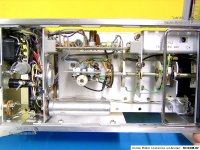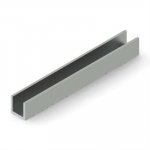Does anybody use isolation/damping when mounting tube sockets to the chassis? I was thinking along the lines of a rubber washer to go between the socket and the chassis, but obviously it needs to be able to deal with a bit of heat.
I have seen shock mounted sockets in test gear in the past, a more common approach appears to be to shock mount a sub-chassis carrying tubes and other shock sensitive parts on the main chassis. (I will be shock mounting a sub chassis in my next line stage project for a couple of DHTs)
Try McMaster-Carr, MSC, Grainger and others for various isolation options..
Try McMaster-Carr, MSC, Grainger and others for various isolation options..
I just use O-Rings around the bolts between the sockets and the chassis. It's not elegant, but it works alright in a guitar amp.
Isolating the valve holder from the chassis only works if the weight of the combined valve holder/valve, when combined with the compliance of the isolating material, form a suitable self-resonance frequency sufficiently below the microphonic frequencies of most concern.
Adding mass around the valve can help that characteristic. I've used high temp silicone rubber to add mass to preamp valves, and that can also stiffen/damp the outer glass tube (which may help a lot depending on the mica internal wall structures).
I've used rubber grommets (they were a favourite of some old manufacturers due to simplicity and cost). Another easier method I've tried is a washer of neoprene (eg. from a mouse mat). But the valve base needs to be isolated from the restraining bolts, so that it effectively floats. The wiring to the valve base needs to also not be stiff - I've seen old commercial gear with spiral coiled wiring coming in to each terminal, but modern light gauge multi-strand wire is very flexible.
Adding mass around the valve can help that characteristic. I've used high temp silicone rubber to add mass to preamp valves, and that can also stiffen/damp the outer glass tube (which may help a lot depending on the mica internal wall structures).
I've used rubber grommets (they were a favourite of some old manufacturers due to simplicity and cost). Another easier method I've tried is a washer of neoprene (eg. from a mouse mat). But the valve base needs to be isolated from the restraining bolts, so that it effectively floats. The wiring to the valve base needs to also not be stiff - I've seen old commercial gear with spiral coiled wiring coming in to each terminal, but modern light gauge multi-strand wire is very flexible.
To get effective vibration isolation, follow the octave rule:-
If the mass of a subunit (eg a tube) together with the support string compliance results in a resonant frequency at least double the resonant frequency of the support system, then you will have effective attenuation of vibration in the subunit.
Just spring isolation of the tube itself doesn't do a lot. With any mechanical damping provided suppressing resonance, it forms a mechanical 2nd order low pass filter.
However, you can spring isolate the tube from the chassis. For ordinary receiving tubes, grids tend to resonate in the mid audio range - typically 500 Hz or so. You can choose a spring to resonate lower than say 200 Hz. As well as that, you can mount the chassis on rubber or springs isolators such that the chassis resonates below say 100 Hz. This usually isn't difficult. As far as the valve internals are concerned, this is now a well damped mechanical 6th order low pass filter and there will usually be little trouble with vibration.
If the mass of a subunit (eg a tube) together with the support string compliance results in a resonant frequency at least double the resonant frequency of the support system, then you will have effective attenuation of vibration in the subunit.
Just spring isolation of the tube itself doesn't do a lot. With any mechanical damping provided suppressing resonance, it forms a mechanical 2nd order low pass filter.
However, you can spring isolate the tube from the chassis. For ordinary receiving tubes, grids tend to resonate in the mid audio range - typically 500 Hz or so. You can choose a spring to resonate lower than say 200 Hz. As well as that, you can mount the chassis on rubber or springs isolators such that the chassis resonates below say 100 Hz. This usually isn't difficult. As far as the valve internals are concerned, this is now a well damped mechanical 6th order low pass filter and there will usually be little trouble with vibration.
Wow, thanks for the replies, guys. I will have to put my propeller cap on to research this further!
I have successfully used a method I borrowed from Hewlett Packard to isolate low level vacuum tubes from mechanical vibration. Please study the pictire below of an HP 3400A voltmeter. Here a nuvistor is mounted on a small circuit board. This board is sandwiched with soft foam rubber in a channel at each end. A small piece of aluminum (or plastic) with a through hole socket attached can be supported with foam rubber in an aluminum (or plastic) U channel. Simply size things to your needs. And use fine flexible wire to make your connections. This is assuming one is handy with tools and fabricating small parts. The only down side is that in twenty years you'll probably have to replace the foam.
Attachments
Last edited:
- Status
- Not open for further replies.
- Home
- Amplifiers
- Tubes / Valves
- isolating tube sockets

